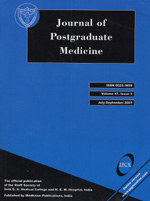
|
Journal of Postgraduate Medicine
Medknow Publications and Staff Society of Seth GS Medical College and KEM Hospital, Mumbai, India
ISSN: 0022-3859
EISSN: 0022-3859
Vol. 49, No. 4, 2003, pp. 316-321
|
 Bioline Code: jp03088
Bioline Code: jp03088
Full paper language: English
Document type: Research Article
Document available free of charge
|
|
|
Journal of Postgraduate Medicine, Vol. 49, No. 4, 2003, pp. 316-321
| en |
Evaluation of Single Photon Emission Computerised Tomography (SPECT) using Tc99m-Tetrofosmin as a Diagnostic Modality for Recurrent Posterior Fossa Tumours
Barai S, Bandopadhayaya GP, Julka PK, Haloi AK, Seith A, Malhotra A
Abstract
BACKGROUND: Brain Single Photon Emission Computerised Tomography (SPECT) has been established as a potentially useful tool for the assessment of recurrent brain tumours. Though brain SPECT is exquisitely sensitive in detecting viable tumour tissue in the supratentorial region, its efficacy has not been evaluated till date in case of infratentorial posterior fossa tumours. AIM OF THE STUDY: To evaluate the diagnostic utility of brain SPECT in differentiating recurrence of tumour from post-radiation gliosis in the posterior fossa of the brain. SUBJECTS AND METHODS: Twenty-one patients with primary malignant posterior fossa brain tumour were evaluated by brain SPECT with Tc99m-Tetrofosmin as the tumour-seeking agent. Clinical behaviour of the tumour observed for a minimum period of one year after the SPECT study was taken as the gold standard. STATISTICAL ANALYSIS: The Chi-square test has been used to note the significance of the association between the clinical outcome and the SPECT finding. In addition, the sensitivity and specificity of brain SPECT were also calculated. RESULT: Brain SPECT in 4 patients revealed increased tracer concentration over the primary tumour bed, which was consistent with recurrent tumour. The clinical course was consistent with tumour recurrence in 13 of the 21 patients, which included 3 patients with positive SPECT study and 10 patients with negative SPECT study. Brain SPECT revealed recurrent tumour in 4 patients whereas clinical follow-up suggested recurrence in 13 patients. The clinical course was consistent with radiation necrosis in the remaining 8 patients. In 1 brain SPECT positive patient the clinical course was consistent with post-radiation gliosis. CONCLUSION: This study demonstrates that brain SPECT is not a sensitive diagnostic modality to differentiate recurrent tumour from post-radiation gliosis in the posterior fossa of the brain.
Keywords
Posterior fossa, Tetrofosmin, Fanbeam collimator, Post-radiation gliosis.
|
| |
© Copyright 2002 Journal of Postgraduate Medicine. Online full text also at http://www.jpgmonline.com
Alternative site location: http://www.jpgmonline.com
|
|
